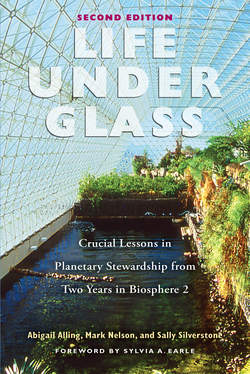Читать книгу Life Under Glass - Марк Нельсон - Страница 13
На сайте Литреса книга снята с продажи.
INTRODUCTION LOOKING BACK ON LIVING IN BIOSPHERE 2
ОглавлениеAND WHAT WAS LEARNED TO GUIDE US THROUGH OUR CURRENT ECOLOGICAL CRISIS
“[Many people] believe that human society may successfully design nature to fit economic aspirations. What Biosphere 2 showed, in a short time, is the lesson that our global human society is learning more slowly with Biosphere 1, that humans have to fit their behavior into a closed ecosystem.”
– Professor Howard T. Odum, University of Florida
IT SEEMS CRAZY TODAY, but in the 1980s the word ‘biosphere’ was not widely known; we often had to spell the word for people! ‘Sustainable’ was equally obscure. The reality that the global biosphere that evolved over billions of years was in fact the life support system for us humans, as well as for all other life on our planet, was not widely understood. Then suddenly, out of the blue, Biosphere 2 appeared housing many of the quintessential biomes of planet Earth: rainforest, savannah, desert, marsh/mangrove, and coral reef ocean. Not only that, but it was uncommon then, if not audacious, to have women as part of such an expedition team and certainly not in equal numbers with men, but our crew was composed of four men and four women. Everyone could relate to Biosphere 2 since it was a miniature version of their lives and world. Because it was so small, just over three acres (2.5 U.S. football fields or 1.5 soccer fields), it was easy to see how people, wilderness areas, farm, and technology are so closely interconnected.
Astronauts don’t have to look over their shoulder; nobody is outside the spacecraft watching their every move. In Biosphere 2, even when we were slogging through a muddy rice paddy, cleaning the underwater ocean viewing windows, or pruning vines in the rainforest to let more sunlight in for shaded plants, there might have been a crowd looking in with their keenly peering faces pushed up against the glass that separated our world from theirs. Captivated by the drama of real-time science and exploration, they encouraged us with their positive smiles and were proof that what we were doing was both new and necessary. We also observed the outside world with new eyes: as we were getting thinner on our low-calorie diet, weaned away from fast food while living off our organic farm, people outside seemed to be getting larger! It was an opportunity for us to learn again about our own Earth’s biosphere as we compared and contrasted the two while we learned from news reports that ecological problems around the world were getting worse. It was this comparison that helped fuel our resolve to successfully complete our two-year experiment in Biosphere 2 and provide some examples of how people take care of their biosphere when they realize it’s what is keeping them alive.
The challenges we faced within Biosphere 2 have since moved from small environmental circles to the front pages of global news reports. Today, we continually hear that natural resources are finite and that even vast reservoirs, like our atmosphere or ocean, can be imperiled by human action. Our aim in Biosphere 2 was to find a way to meet our needs, protect our wilderness areas, and keep our soils, waters, and atmosphere healthy. To do this, we needed innovative technologies to recycle our water, grow food without using harmful chemicals while maintaining the soil’s fertility, and when necessary, intervene to manage our atmosphere and preserve as much biodiversity as possible to enhance the system’s capacity for adaptation and resilience. Our approach in the design of Biosphere 2, such as selecting non-polluting technologies to support ecology, directly relates to our Earth’s biosphere because it too is essentially a closed system. That no one knew then if this was possible, made Biosphere 2 one of the most forward-thinking and daring experiments of its time.
Over the past two decades, we have continued to ‘digest’ and explore the unique journey we shared and have developed a greater appreciation of why Biosphere 2 was an important laboratory, as well as a life-changing experience for each of us. But Biosphere 2’s accomplishments and relevance to our current ecological crises have never been fully appreciated. Hence, the importance of this expanded second edition of Life Under Glass, because the urgency of biospheric thinking and action can no longer be delayed without deepening the ecological catastrophe already underway.
